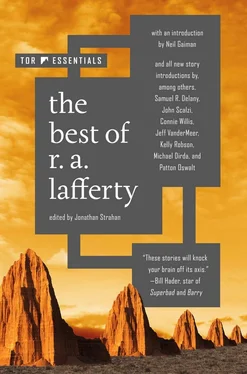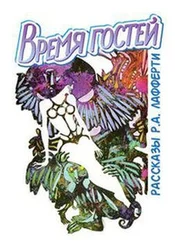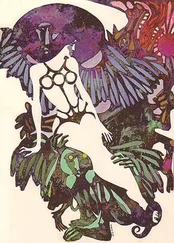—a tendency to attribute to the Shelni an intelligence which they do not possess, perhaps due to their fancied human resemblance. In maze-running they are definitely inferior to the rodents. In the manipulation of latches and stops they are less adept than the earth raccoons or the asteroid rojon. In tool handling and true mimicry they are far from equal to the simians. In simple foraging and the instinct for survival they are far below the hog or the harzl. In mneme, the necessary prelude to intelligence, they are about on par with the turtles. Their “speech” lacks the verisimilitude of the talking birds, and their “music” is below that of the insects. They make poor watchdogs and inadequate scarecrows. It appears that the move to ban shelniphagi, though perhaps sincere, is ill-advised. After all, as an early spaceman put it, “What else are they good for?”
Well, we have to admit that the Shelni are not as intelligent as rats or hogs or harzls. Yet I, surely due to the influence of Holly, feel a stronger affinity to them than to rats or hogs or coons or crows or whatever. But no creature is so helpless as the Shelni. How do they even get together?
The Shelni have many sorts of songs, but they do not have any romantic songs in our sense. After all, they are small children till they die of old age. Their sexual relationship seems distinguished either by total unawareness or by extreme bashfulness.
“I don’t see how they bring it off at all, Vincent,” Holly said the second day (which was yesterday). “They are here, so they must have been born. But how do these bashful and scatterbrained three-year-olds ever get together to bring it off? I can’t find anything at all in their legends or acting patterns, can you?
“In their legends, all their children are foundlings. They are born or discovered under a blueberry bush (my translation of spionam ). Or alternately, and in other cycles, they are found under a quicken tree or in a cucumber patch. In common sense we must assume that the Shelni are placental and viviparous. But should we apply common sense to goblin folk?
“They also have a legend that they are fungoid and spring out of the ground at night like mushrooms. And that if a Shelni woman wishes a child, she must buy a fungoid slip from a Skokie and plant it in the ground. Then she will have her child ready the next morning.”
But Holly was depressed yesterday morning. She had seen some copy by our sponsor The Singing Pig Breakfast Food Company and it disturbed her:
“Singing Pig! The Children love it! Nourishing Novelty! Nursery Rime Characters in a can for your convenience! Real Meat from Real Goblins! No fat, no bones. If your can has a lucky number tab, you can receive free a facsimile Shelni jug flute. Be the first on your block to serve Singing Pig, the meat from real Goblins. Cornstarch and natural flavor added.”
Oh well, it was only an advertisement that they used back on World. We had our recording to do.
“Vincent, I don’t know how they got here,” Holly said, “but I know they won’t be here very long. Hurry, hurry, we have to get it down! I will make them remembered somehow.”
Holly got them to play on the tines that second day (which was yesterday). There had been an impediment the day before, she said. The tines may not be played for one until the second day of acquaintance. The Shelni do not have stringed instruments. Their place is taken by the tines, the vibrating, singing forks. They play these many-pronged tuned forks like harps, and in playing them they use the tree roots for sounding boards so that even the leaves in the air above partake a little of the music. The tines, the forks are themselves of wood, of a certain very hard but light wood that is sharp with chert and lime dust. They are wood, I believe, in an early stage of petrifaction. The tine fork music usually follows the jug flute music, and the ballads that are sung to it have a dreamlike sadness of tone that belies the childish simplicity of the texts.
Here are two more of those ballad stories that we recorded on the second day (which was yesterday). The Skokie Who Lost His Wife
This is the way they tell it.
A Skokie heard a Shelni jug flute jugging one night.
“That is the voice of my wife,” the Skokie said. “I’d know it anywhere.”
The Skokie came over the moors to find his wife. He went down into the hole in the ground that his wife’s voice was coming from. But all he found there was a Shelni playing a jug flute.
“I am looking for my poor lost wife,” the Skokie said. “I have heard her voice just now coming out of this hole. Where is she?”
“There is nobody here but myself,” the Shelni said. “I am sitting here alone playing my flute to the moons whose light runs down the walls of my hole.”
“But I heard her here,” said the Skokie, “and I want her back.”
“How did she sound?” asked the Shelni. “Like this?” And he jugged some jug music on his flute.
“Yes, that is my wife,” said the Skokie. “Where have you hidden her? That is her very voice.”
“That is nobody’s wife,” the Shelni told the Skokie. “That is just a little tune that I made up.”
“You play with my wife’s voice, so you must have swallowed my wife,” the Skokie said. “I will have to take you apart and see.”
“If I swallowed anybody’s wife I’m sorry,” said the Shelni. “Go ahead then.”
So the Skokie took the Shelni apart and scattered the pieces all over the hole and some of them on the grass outside. But he could not find any part of his wife.
“I have made a mistake,” said the Skokie. “Who would have thought that one who had not swallowed my wife could make her voice on the flute!”
“It is all right,” said the Shelni, “so long as you put me together again. I remember part of the way I go. If you remember the rest of the way, then you can put me together again.”
But neither of them remembered very well the way the Shelni was before he was taken apart. The Skokie put him together all wrong. There were not enough pieces for some parts and too many for others.
“Let me help,” said a Frog who was there. “I remember where some of the parts go. Besides, I believe it was my own wife he swallowed. That was her voice on the flute. It was not a Skokie voice.”
The Frog helped, and they all remembered what they could, but it did not work. Parts of the Shelni could not be found again, and some of the parts would not go into him at all. When they had him finished, the Shelni was in great pain and could hardly move, and he didn’t look much like a Shelni.
“I’ve done all I can,” the Skokie said. “That’s the way you’ll have to be. Where is Frog?”
“I’m inside,” said Frog.
“That’s where you will have to stay,” the Skokie said. “I’ve had enough of both of you. Enough, and these pieces left over. I will just take them with me. Maybe I can make someone else out of them.”
That is the way the Shelni still is, put together all wrong. In his wrong form he walks the country by night, being ashamed to go by day. Some folks are startled when they meet him, not knowing this story. He still plays his jug flute with the lost Skokie wife’s voice and with Frog’s voice. Listen, you can hear it now! The Shelni goes in sorrow and pain because nobody knows how to put him together right.
The Skokie never did find his lost wife.
This is how it is told.
And then there was the second story that we recorded yesterday, the last story, though we did not know it then, that we would record of the Shelni: The Singing Pigs
This is how they say it.
We have the ancient story of the singing pigs who sing so loud that they fly up into the sky on the tail of their own singing. Now we ourselves, if we can sing loud enough, if we can jug the flutes strong enough, if we can tang the tines deep enough, will get to be the Singing Pigs of our own story. Many already have gone away as Singing Pigs.
Читать дальше




![Рафаэль Лафферти - Дни, полные любви и смерти. Лучшее [сборник litres]](/books/385123/rafael-lafferti-dni-polnye-lyubvi-i-smerti-luchshe-thumb.webp)
![Рафаэль Лафферти - Лучшее [Сборник фантастических рассказов]](/books/401500/rafael-lafferti-luchshee-sbornik-fantasticheskih-ra-thumb.webp)